The History of Caroline County, Maryland, From Its Beginning
Federalsburg (North West Fork Bridge), Hickory Hill, Nichols, Houston's Branch
FEDERALSBURG (North West Fork Bridge)
Origin and Unification of the Town
The first inhabitants of the county around Federalsburg were the tribes
of the Nanticoke Indians. Although they were not so fierce as the
Susquehannoughs of northern Maryland, neither were they so friendly as
the Piscataway tribes of the western shore. Whether this attitude
toward white people delayed the settlement of the county we cannot say;
but as early as 1682 James and William
Wright, who came from England (probably Bristol) with one of William
Penn’s colonies, settled on Marshyhope Creek, the headwaters of the
Northwest Fork of the Nanticoke River. When Caroline County was
formed in 1774, this land fell within its boundaries. By an act of
the General Assembly of 1792 the southern boundary was extended to Noris
Ford (a corruption of Northwest Fork Ford), because the newly erected
bridge at that spot had taken the place of the one which had marked the
Caroline-Dorchester division line before it had been washed away.
Already the possibilities of this
point where cross-country traffic forded the river had been foreseen by
a Mr. Cloudsberry Jones, who built a store, and
began to sell groceries and liquor there about the year 1789. The
was the nucleus of a small village which so patently owed its growth to
the bridge that it was called “Northwest Fork Bridge,” or “The Bridge”
until early in 1812 when politics too the naming of the little town in
hand. By this time the Federalist Party had reached that stage of
decline which is characterized by a fever-heat of loyalty and
enthusiasm. The party was strong on the Delaware-Maryland
peninsula, and a rousing mass-meeting was held at “The Bridge.”
People came from far and near; the militia drilled and paraded with all
the pomp and ceremony of military glory; drums beat and fifes shrieked;
the Stars and Stripes, together with the party flag, were cheered to the
top of an immense flag pole; prominent speakers of the day used
all their gifts of oratory to foster the pride, and kindle the
enthusiasm for party and party principles. Something must be done,
such emotion demanded an outlet; of the patriotism, enthusiasm, and
party loyalty of that day was born a name for the town—Federalsburg.
The few Republicans of the locality voiced their protest by still
referring to “The Bridge”; however, though Republican principles finally
triumphed, the Federalist name was held and Federalsburg it has ever
remained.
The road following the river had been
made the boundary between Caroline and Dorchester counties through that
section which is now the site of Federalsburg; but as the line of houses
which grew up along it developed into proportions of a village, this
dividing line threatened the peaceful existence and growth of the town.
People living on the west, or Dorchester, side of Main Street, sent
their children to the village school. Those living on the East, or
Caroline, side sent them to the district school at Tanyard Branch, a
mile and a half distant. The residents of the same town paid their
taxes into separate county treasuries, and were more or less attached to
separate interests. Offenders against the law could baffle and
embarrass its officers merely by dodging from one side of the street to
the other. Moreover, voters in Caroline County had to go to
Linchester to cast their ballots, while the Dorchester population went
either to East New Market or to Crotcher’s Ferry according to the
section of the village in which they lived.
So great and so general had the
dissatisfaction over these inconveniences become by 1880 that a petition
signed by every voter in the Dorchester part of town, seventy in all,
was sent to the Legislature asking for such a change in the boundary
between the two counties that the town and its suburbs might be wholly
within Caroline County. This request was granted, and upon the
payment of $614 into the Dorchester treasury by the transferred
taxpayers, the change was duly authorized and made. Thus, with the
wiping out of the dividing line, Federalsburg became a unified whole.
EARLY INDUSTRIES
Probably Federalsburg’s earliest industry, and certainly its most picturesque one, was its shipbuilding. The surrounding white oak forests furnished the material, but as this industry ante-dated the saw-mill, the old-time whip-saw had to be employed to convert it into lumber. To operate this saw a trestle was erected; one man sawed from the elevated position while his co-laborer at the other end of the saw worked on the ground. As the water was too shallow for these ships to be launched at Federalsburg anyway, it was not important that they be built at any definite place; hence keels were laid at many different points in the southern part of the town.
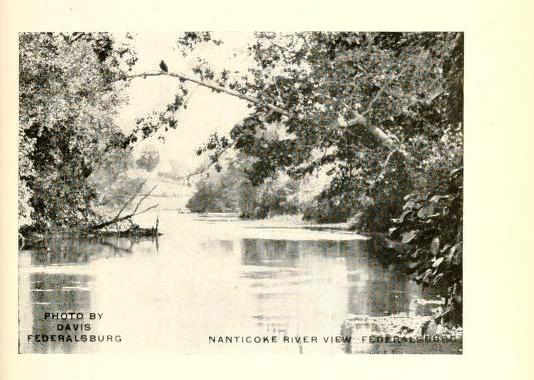
Upon the completion of a ship, it was conveyed on a scow, or lighter, to
Brown’s Wharf, a landing four miles farther down the river. From
thence it was launched, laden, and sent upon its career as a bay and
river trading vessel. The same landing was naturally the
shipping point for Federalsburg merchants, although boats of lighter
draft ascended as far as Chimney Landing, a distance of less than two
miles from the town. Twice yearly, in spring and in fall, the
local store-keepers loaded a boat with tan-bark and cord-wood, and
returned from the Chesapeake cities with a miscellaneous supply of city
needfuls for their country trade.
The first ship built at Federalsburg
was “The Clipper.” This was followed by the “Richard Tull,” the
“Eggleston Brown,” the “Mary Havelow,” the “Jacob Charles,” the “Pearl,”
and the “Annabelle.” Of these the “Pearl” was the largest and best
equipped, and the “Annabelle,” built by Mr. Jacob Covey, and named for
his two daughters, was the last. The industry ceased at
Federalsburg some time before the Civil War.
Exclusive of shipbuilding, the work
of the town centered around the mill-dam at its northern extremity. Mr.
John Elliott owned and operated the mills there.
At these mills, later known as “Idlewild Mills,” logs which had been
floated up from considerable distance downstream while the tide was
coming in, were converted into lumber, in which form they made the
return trip down the river and on to Baltimore. To the Idlewild
mills also came the fleeces from the countryside, there to be carded and
combed, and made into “rolls” for the spinning wheels of thrifty
housewives. Thence, too, came the wheat, destined eventually to be
molded into the smooth, round “Maryland Biscuit,” and the corn for the
quick batter bread. Smelting iron-ore obtained from the valley of
the town was tried for a time, but it proved unprofitable. As a
means of furnishing power for grinding wheat and corn, and for
generating electricity the dam was used continuously until the last mill
was burned in 1916.
Fifty years ago, and more, all the
merchants bought tanbark just as they buy butter, eggs, and other farm
products today. The bark was cut into slabs and sold by the cord.
Spanish oak bark commanded the higher price. It was shipped in the
slab form in which it was bought at the country stores. Black oak
bark, however, was shredded after the coarse, sapless part of the bark
had been removed. Mr. Henry Mowbray, who kept a
store at “The Point,” was the only person who shredded the bark.
Prior to the year 1840 there had been a tanyard of some importance on
the farm of a Mr. Wright, one and one-half miles east of town. By
that time, however, the tan-pits had fallen into disuse, and the
building in which hides had been stored was being used as a schoolhouse.
The industry, thus abandoned, has never been revived in the vicinity,
but the name, “Tanyard Branch,” still marks the site of the activity.
THE FEDERALSBURG TAVERN
In the days before the Civil War there was located in Federalsburg an
old-fashioned tavern, originally owned by a man named Perry. It
stood on the east side of the bridge crossing the North West Fork, about
ten or fifteen feet back from the road on the meadow land adjoining the
late
T. O. Jefferson property. The structure was
mounted on the slope of the hillside, so that while the rear of the
building rested on the ground the main entrance was reached by a steep
flight of steps. Rectangular in shape, having two stories topped
off with an ample garret under the roof, this old tavern was similar to
the colonials inns of the time of George III.
Like them, its first proprietors were
dispensers of liquor. Later in its history it became a stopping
place for Negro traders on their way to Patty Cannon’s at
the Johnson’s Cross Roads.
In later years this old inn was used as a private dwelling by various
Federalsburg families. It was while being occupied by Mr.
Hill Smith that the building was finally destroyed by
fire.
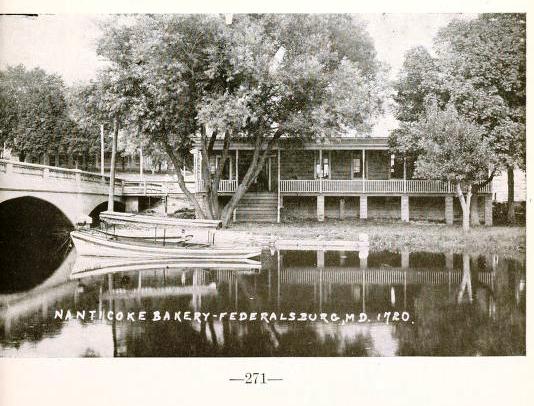
HISTORY OF TRANSPORTATION
The rivers and bays of a new country are its first routes of trade and
transportation. Hence river traffic with Baltimore, as well as
with some smaller towns of the Chesapeake, began at an early date.
Cordwood, lumber, tanbark, and wheat, as well as less bulky products
were loaded on to heavy scows and pushed down the river by four or five
muscular men using long poles. At Brown’s Wharf, four or five
miles below Federalsburg, these commodities were reloaded upon schooners
or other sailing vessels and sent up the bay.
Before the Civil War there was little
cross-country transportation for anything except mail and passengers.
For these there was the picturesque old stagecoaches. Even after
the war, they made daily trips from Bridgeville to Federalsburg, and
thence to Cambridge and Easton. These lines were operated by Mr.
Wesley Moore and Mr. James Finsthwaith.
The Seaford and Cambridge division of
the Pennsylvania Railroad was opened for traffic on Oct. 12, 1868,
although at that time it extended only from Seaford to East New Market.
This date marked a new era in the history of Federalsburg, for it is
that railroad, with its refrigerator car accommodation, which made New
York, Philadelphia and other northern cities the markets for the
perishable products of our gardens and orchards.
UNTIED METHODIST EPISCOPAL CHURCH
This church was organized in 1785, in a house owned and occupied by Jacob Charles. This house stands near the bridge which spans the North West Fork of the Nanticoke river which flows through the town, and is at this date, 1919, occupied by Mr. and Mrs. John Smith. The first church building was erected in 1815, and stood within the bounds of the present cemetery. The ground was purchased from one Eccleston Brown and his wife, for the consideration of sixty cents. Upon this ground a frame building was erected for the use of the Methodists as a place of worship. The trustees were Paul Conaway, Constant Wright, Joshua Wright, Ferdinand Griffith and William Frampton. This building was occupied as a place of worship for both colored and white people until 1850, when it was sold and moved to a point about one hundred yards south, and on the East side of Main street, where it was occupied as a carpenter shop for a number of years. Later it was sold and a part of it moved to the rear of the residence now occupied by Charles M. Davis and wife, and still serves as a part of his outbuildings. The present church building, that is the main part, was built in 1850, on ground bought from Jacob Charles and wife. Again the consideration was the sum of sixty cents. At this time the board of trustees consisted of Paul Conaway, Jacob Charles, Charles Willis of E., John Elliott, Joseph L. Kenney, Curtis Davis and William M. Wingate, M.D. In the years 1901 and 1902 the building was repaired, and enlarged by the addition of an annex on the south side. The cost of the improvements was $3375.00. The building was reopened for worship on the 29th day of June, 1902. At this time the Rev. Thomas S. Holt was the pastor. In the year 1912 the building was again repaired and enlarged by the addition of a room in the rear for the accommodation of the Beginners and the Primary departments of the Sunday school. The cost of these improvements was $1,400.00.
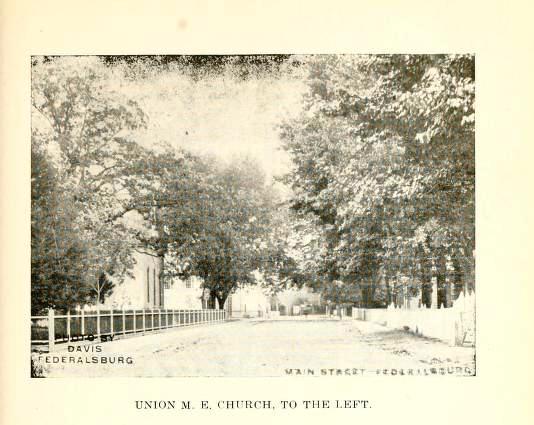
In 1914 a pipe organ was installed at a cost of $1,700.00. These
last improvements were made during the pastorate of the Rev.
T. E. Terry, from 1912 to 1914.
For many years the church was a part
of a large circuit, during which time preaching on the Sabbath was done
by local preachers, the pastors only preaching during the week.
Later it was made the head of a smaller circuit, with preaching by the
pastor on the Sabbath. In 1902 the charge was made a station.
By Rev. F. C. MacSorley.
CHRIST METHODIST PROTESTANT CHURCH
The present structure, now known as Christ Methodist Protestant Church
of Federalsburg, was originally Federalsburg Presbyterian Church,
therefore, any sketch or history of Christ church in order to be in any
way complete must include the history of the Presbyterian church which
was the beginning of it.
In the year 1871 under the leadership
of a Rev. Mr. Boing a congregation was
assembled and October 6th regularly organized as a Presbyterian church. Mr.
H. P. Chambers was elected Secretary and Messrs. Jas.
A. Sanders, Edward R. Goslin, John Wilson, Jacob Rhoads and H. P.
Chambers were the Finance Committee. The original
trustees were Edward R. Goslin, H. P. Chambers, W. C.
Logan, R. Mithchell, J. Rhoads, J. A. Sanders, Dr. W. D. Noble and John
Wilson.
A hall was rented and properly seated
and the services proceeded regularly until the present fine structure
was erected. The lot on which it stands was bought from Dr.
Noble and the building erected during the years 1872
and 1873.
Regular services were held after this
until the year 1897. At this time most of the congregation had
moved away or died and it was decided to abandon the work and leave the
property in the hands of the New Castle Prebytery. The last
meeting of the session was recorded on Sept. 30th, 1897, by S.
A. Logan, Clerk. Rev. Mr. Blackwell was
Pastor at Bridgeville and served this church in connection with that
charge.
For about five years after that the
church remained closed.
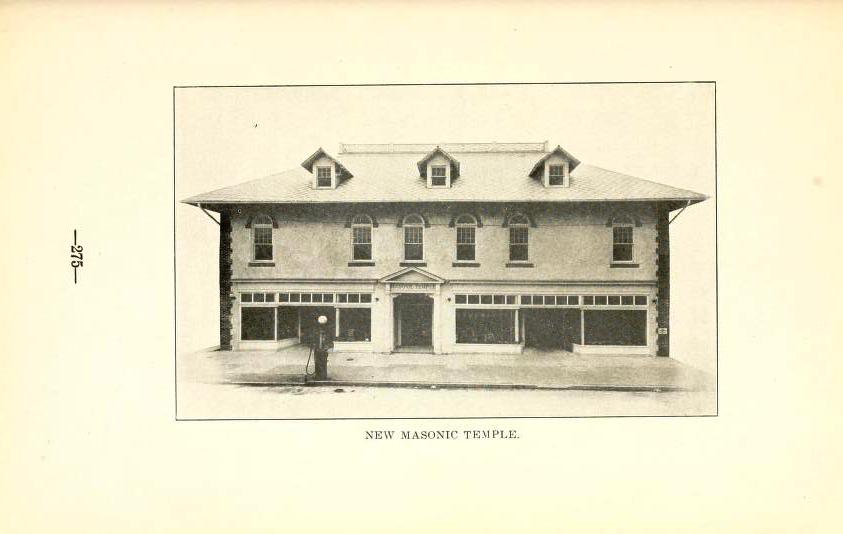
In 1902, a number of Methodist Protestant
families having moved into the town and vicinity, it was decided to form
a Methodist Protestant church. Mr. James B. Wright,
a loyal Methodist Protestant, seeing the need, bought the church
building from the New Castle Presbytery and advanced the money until
such time as the congregation should be able to repay him. Rev.
Herbert F. Wright, who was then Pastor at Reliance, opened services
in the church building and June 12, 1902, Christ Methodist Protestant
church was duly organized.
Since that time services have
continued to be held continuously and the church has gained until it has
reached its present strength and usefulness and has become one of the
strongest powers for good in the community.
By Rev. J. L. Nichols.
SCHOOLS
The first school in Federalsburg was situated on the west side of Main
Street midway between Academy Avenue and the M. P. Church. One of
the first teachers was Mr. Thomas Brown, who settled
here in the latter part of the eighteenth century. This building was
accidentally burned during the first term taught by Miss
Lizzie Goslin. It, as well as its successor, built near the
point where Main Street became the Preston road, was under the
management of Dorchester County. The first Caroline County school
within town limits stood adjoining the present site of the M.E. Church.
Following these came the
Academy, at first a one-room frame structure over which Miss
Augusta Paine first presided as school-mistress.
With the growth of the town, however, other rooms were added until when
last used, it comprised six rooms. Even the conversion of an
adjacent machine shop into a primary school failed to meet the growing
demands of the town and community; a more commodious building was an
imperative necessity.
One of the last public acts of the Hon.
E.E. Goslin, who had championed the Academy and donated the first
five hundred dollars to it, was to obtain the passage of a bill
appropriating money for the erection of the present High School
building, first occupied in 1915. This building is a large stucco
structure of two stories and basement. Its thirteen classrooms,
auditorium, lunchroom, library, textbook room, office and restroom, are
heated by steam. Electric lights, bells, telephones, and running
water are other modern conveniences which help to make it one of the
finest and best equipped schools on the Eastern Shore.
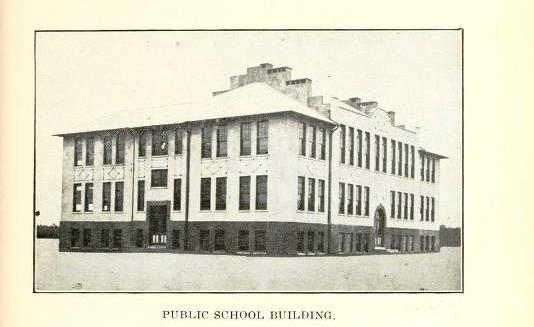
COLORED SCHOOLS
Standing where Main Street curves to form the “Point” is a little shop where Mr. Richard Tull (a white man) did carpenter work by day and taught the colored inhabitants by night. Somewhat later a schoolhouse was built for them at Quaker Branch, where the Houston’s Branch road leaves town. A part of the old colored church opposite Mt. Pleasant Cemetery also did service as an institution of learning until the erection of the attractive new building on the Nichols road met existing need. (From material collected by Federalsburg Pupils.)
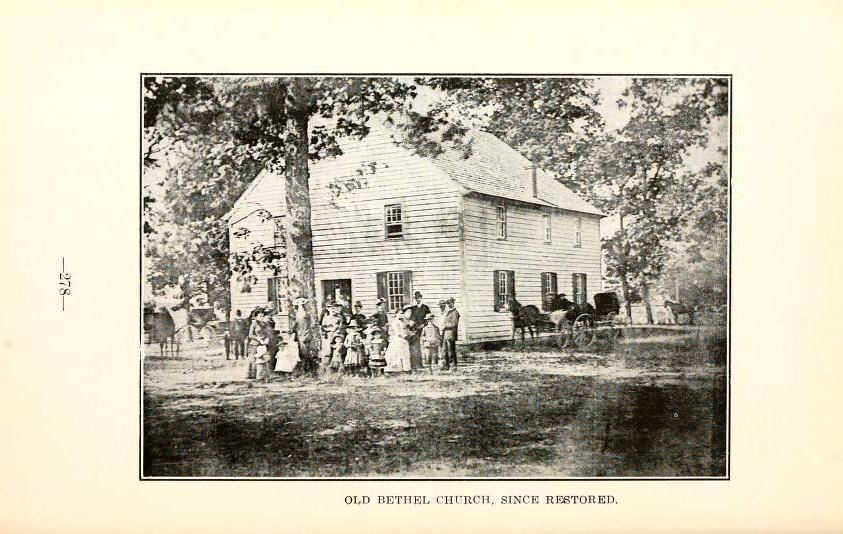
HICKORY HILL
In the year 1872 a piece of land was bought from Mr.
Alfred Davis and Mr. James Willis on
which to build a school.
The school was built in a hickory
grove on a small hill, so they decided to call it Hickory Hill. In
1916 the school was burned, then for two years the children of this
section went in a hack to Federalsburg school.
In the year 1918 the people in the
vicinity of Hickory Hill School met and subscribed a certain amount of
money to erect a new school. At the end of the year the new school
was completed. Two miles away from Hickory Hill School is a church
by the name of Liberty that was built in the year 1907.
In the year 1863 the slaves of the
United States were freed by our president, Abraham
Lincoln. Many of the slaves of the United States were badly
treated. There were many kidnappers in the east. Kidnappers
caught the Negroes wherever they went and then sent them south and sold
them for a good price. The greatest kidnapper near Hickory Hill
neighborhood was Patty Cannon. She was as
strong as a man and lived where Reliance now stands. She went
around in a one-horse wagon trying to catch Negroes. She would
invite them to take a ride with her, and when they were in the wagon
would throw them down and tie them hand and foot. Then she would
take them to her home and put them in her slave pen, until she had
enough to send south and sell.
Pupils of Hickory Hill.
NICHOLS
The old schoolhouse built of logs many years ago, stood near where Mr.
Cohee’s house now is. It was named Midway because it was about
halfway between Friendship and Federalsburg.
The present school site was purchased from James A.
Nichols in 1896, since which time it has been known
officially as Nichols School.
A sorgum mill was also built in this
section long ago. Mr. Corkran built
it.
HOUSTON’S BRANCH
Houston’s Branch is the name applied to a small stream emptying into the
North West Fork a few miles above Federalsburg. It was evidently
named for James Houston who came to
this section from Sussex County about 1800 and became one of the most
representative citizens of this section and well known in county
affairs. Mr. Houston was probably the
earliest miller in this neighborhood.
As English and Scotch people settled
this community largely, their descendants naturally clung to the
Episcopal church—so much so in fact that a church of that denomination
was established here years ago. For lack of support, however, it
ceased to thrive and finally was closed.
After the Liberty school district was
divided about 1871, the Houston’s Branch school district was laid off
and a building erected. With the exception of one or two years
when the school was closed because of poor attendance, it has been in
operation ever since. To this school belongs the honor of having
the first concrete steps in the county, built by the patrons during the
incumbency of Mrs. S. E. Parsons, teacher.